Let me introduce Svíčková na smetaně to you, the queen of Czech sauces. This creamy sauce is popular among Czechs, but it’s also typical food that everybody should try while visiting the Czech Republic. Here is a step-by-step recipe on how to make svíčková from scratch!
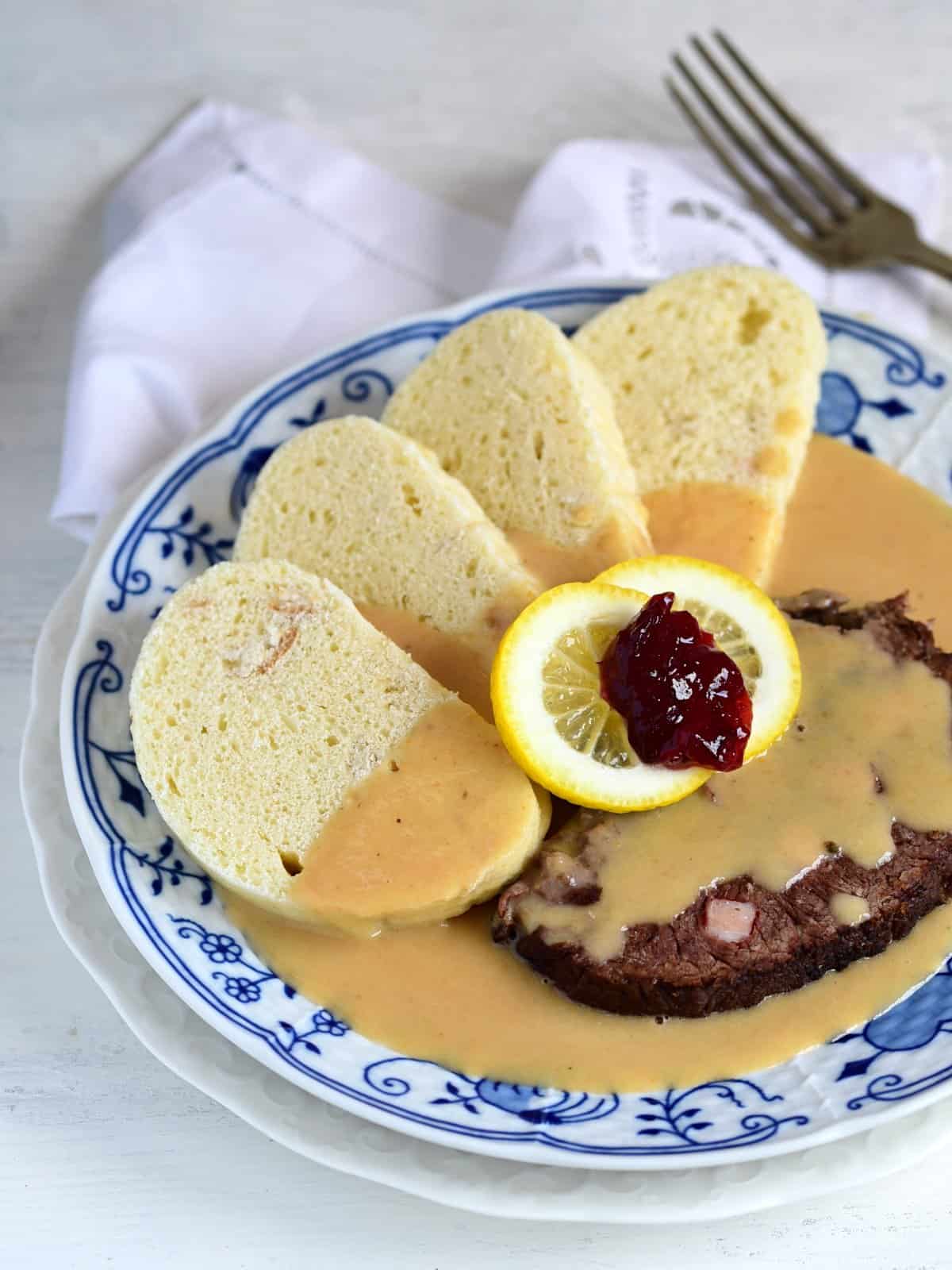
➜ What Is Svickova na smetane?
Svíčková is a famous sauce from Czech cuisine, made from root vegetables and heavy cream. It’s thickened with roux.
Svíčková sauce is eaten warm and poured over a beef slice, accompanied by bread dumplings. You can also garnish the final dish with lemon, cranberries, and a scoop of whipped cream.
The literal translation could be “Beef tenderloin in cream sauce”, but I don’t know any single Czech who would use this beef cut (tenderloin/fillet mignon) for svíčková. More about the best beef cuts for svíčková further in the article.
Making svíčková is not hard; you don’t need any fad ingredients. The magic lies in the process, which you have to carefully follow step-by-step, with the result being a flavorful and rich sauce.
TIP: Svíčková belongs among traditional Czech foods, often served as part of a wedding menu.
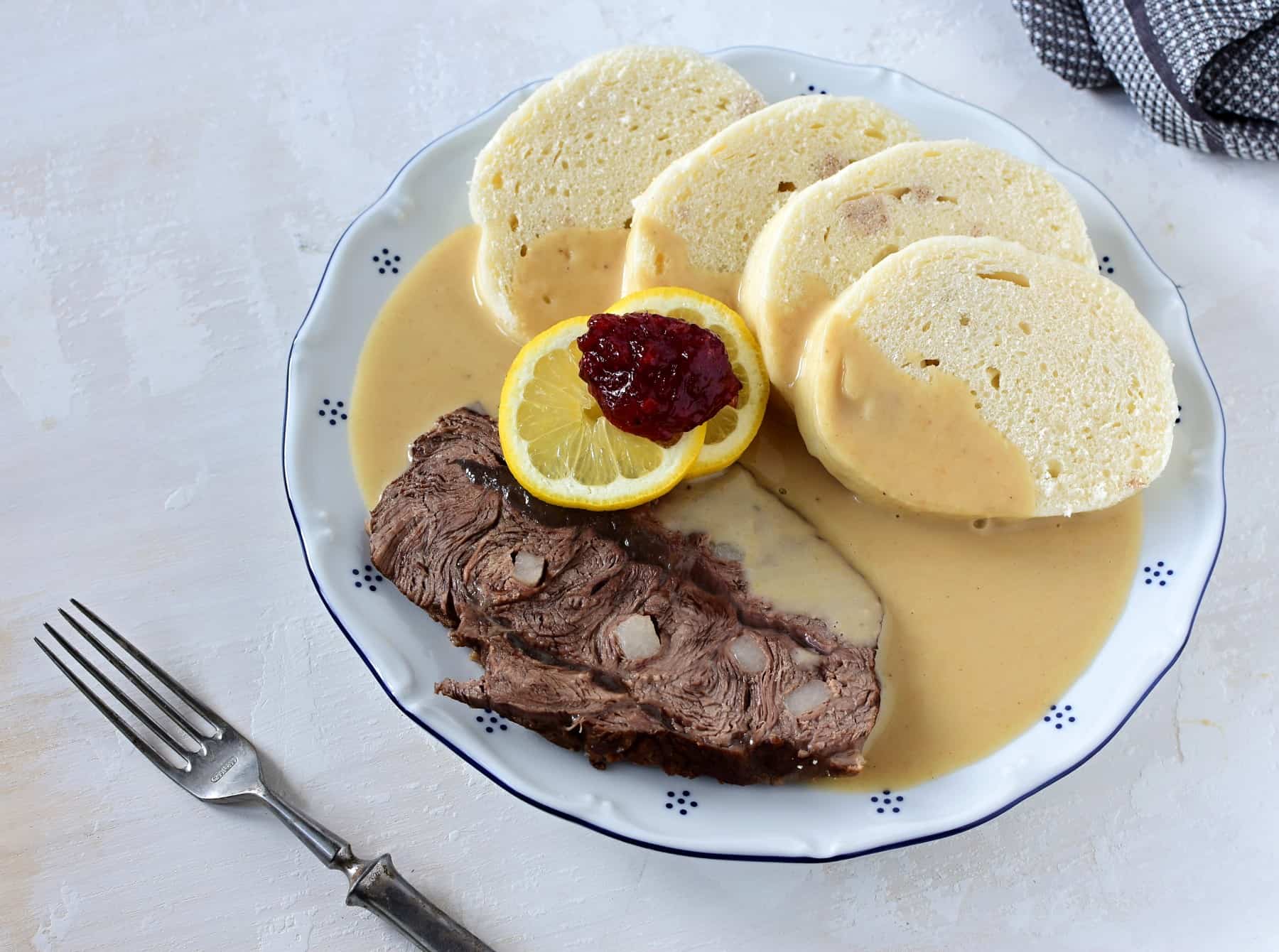
NOTE: Please note that preparing svíčková can take anywhere from 3 to 3.5 hours, so plan ahead!
➜ Pronunciation
I recorded a short audio clip on pronouncing the Czech word svíčková. The first word in the audio is "svíčková", the last is "svíčková na smetaně", which means svíčková with cream.
➜ Two Reasons Why Home Cooks Might Fail Making Svíčková
I saw many recipes on the internet containing errors and mistakes. A long story short, here are two primary insults against the traditional, real svíčková recipe:
1. The sauce is NOT thickened with roux.
To thicken svickova, mixing the vegetables and cream only at the end of cooking is not enough.
In this case, the liquid separates from the vegetables and will be absorbed by the dumplings. The result won’t look nearly good enough.
Roux is a must; it brings the sauce together and gives it its typical satin texture. In Czech is roux known as "jíška" or "zásmažka".
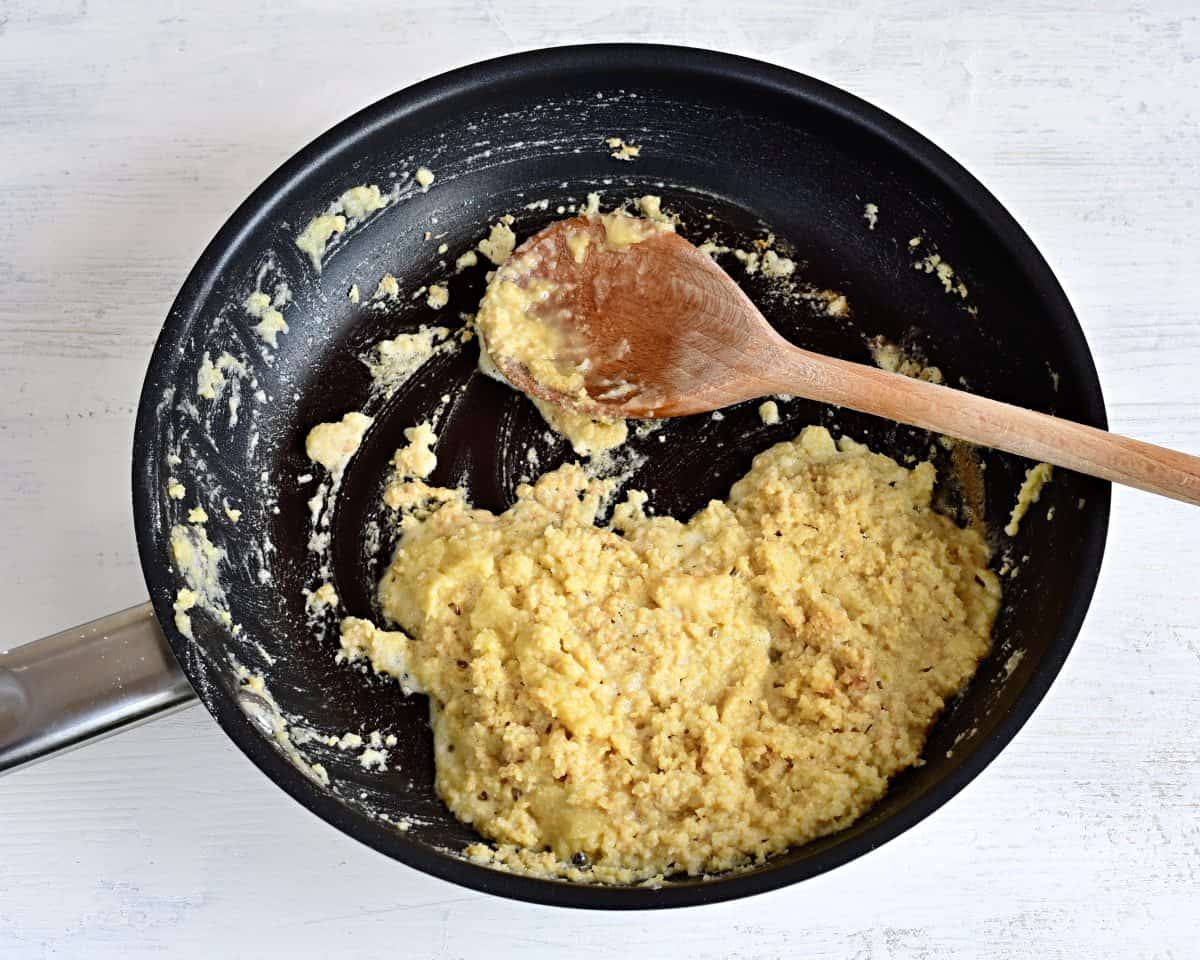
2. The base with vegetables is NOT sauteed & seasoned well initially.
You can't throw vegetables into a pot and expect the svickova sauce to appear in the pot at the end of cooking magically.
As a first step, you must sauté diced vegetables with butter and season them with sugar, salt, and vinegar.
It takes some time, but if you do this part faithfully, svíčková’s taste will be strong and darn delicious from the very beginning!
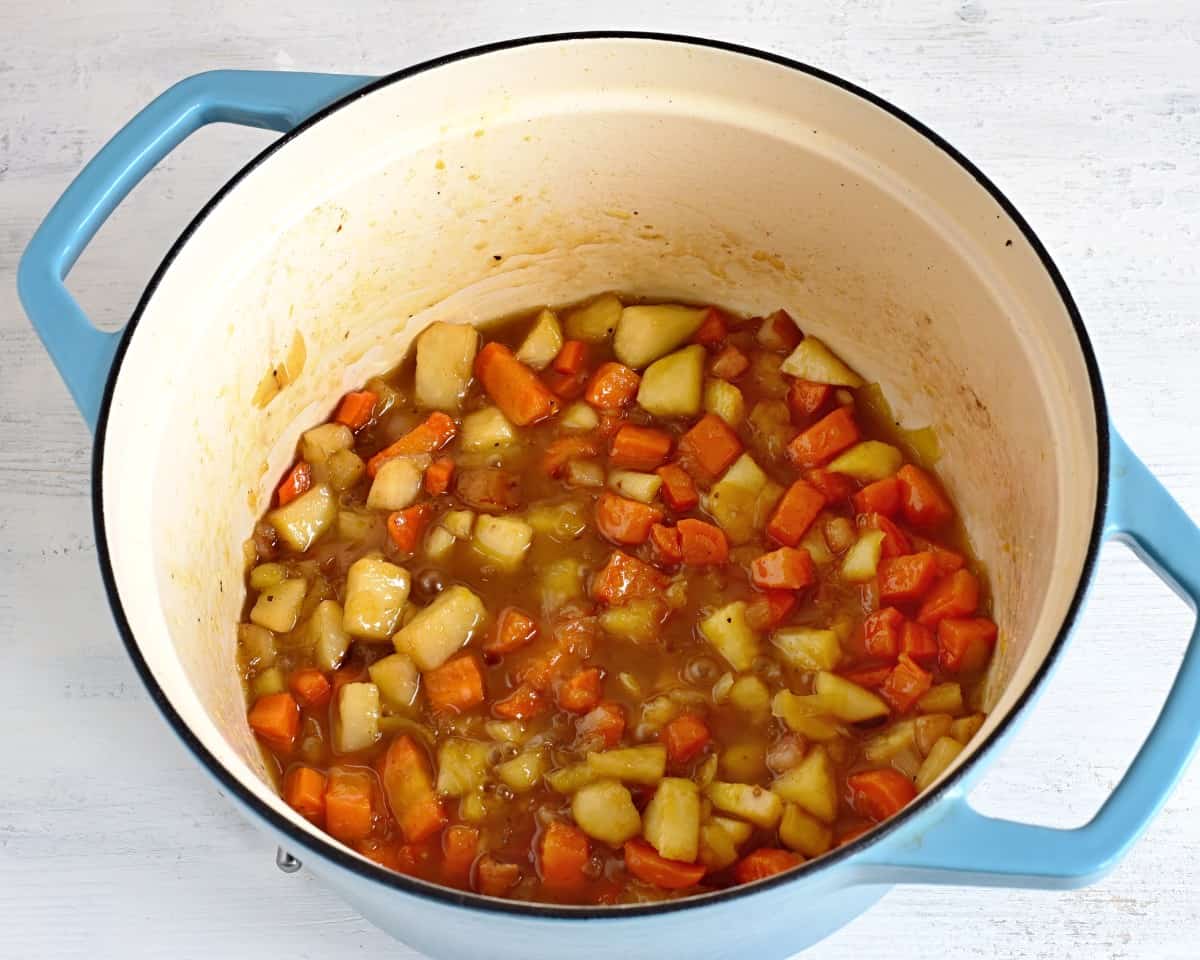
➜ Ingredients
Let’s go on and take a peek at the ingredients needed to make svíčková:
- Beef; many respected Czech cooks recommend top blade or bolar blade; in this recipe, I used a piece of the top blade (loupaná plec in Czech)
- Fat bacon; to lard the beef
- Vegetables: parsley roots, carrots, celeriac, onions
- Apple; for a smoother taste
- Lard; to brown the beef
- Butter; to sauté vegetables
- Granulated sugar; to sweeten svíčková
- Heavy cream; must contain at least 30 % or more milk fat
- Vinegar
- Lemon juice; for final seasoning
- For roux: unsalted butter and all-purpose flour
- Spices: bay leaves, peppercorn (black pepper berries), allspice balls
- Salt and ground pepper
✅ You’ll find the exact amount of ingredients below in the recipe card, which you can also print out.
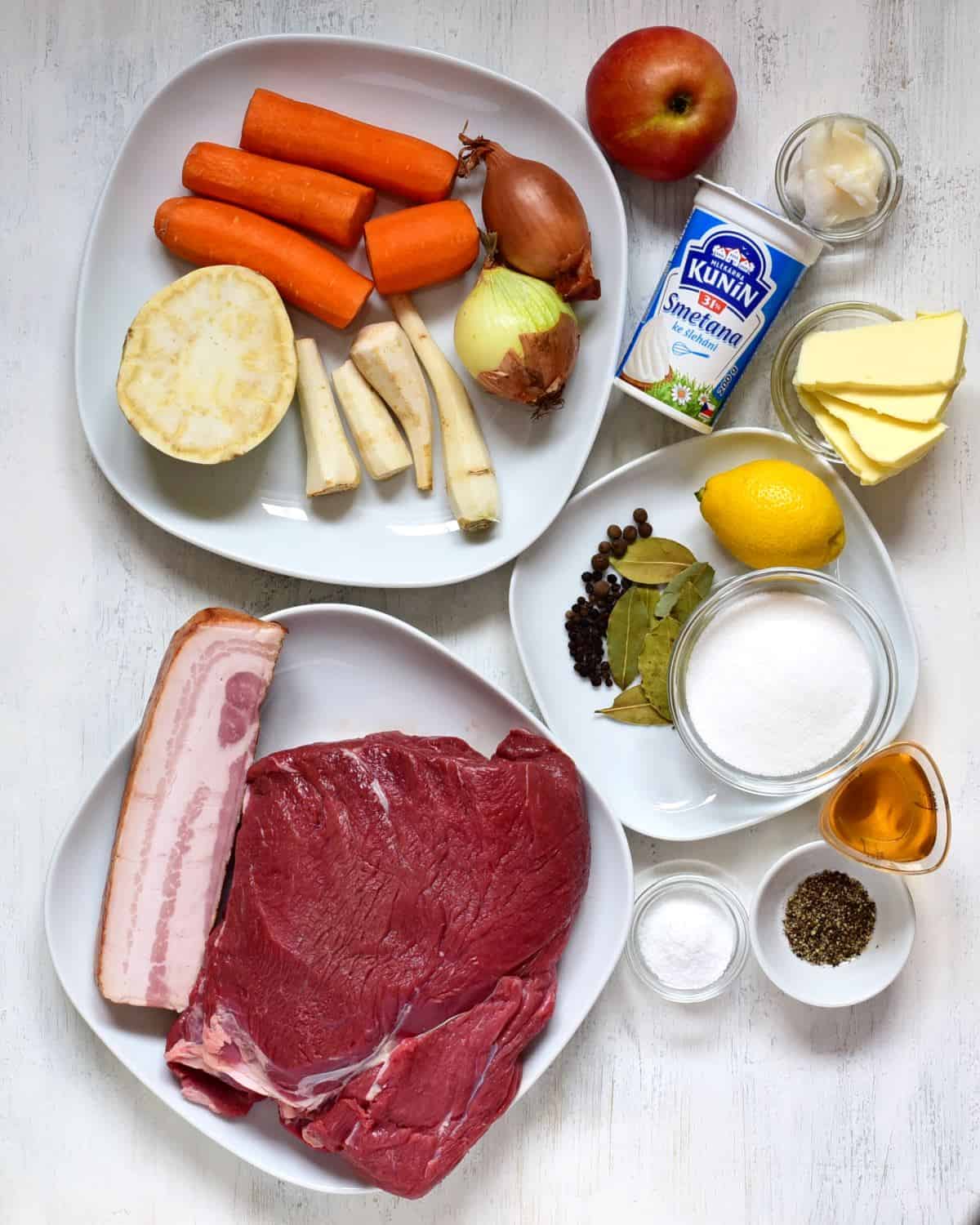
NOTE: In the photo, there are not ingredients for roux included (all-purpose flour and butter).
➜ Detailed instructions with photos
There are a lot of svíčková recipe variants. In some cases, they want you to marinate the meat beforehand, pour in some wine or add thyme and other spices and herbs. Some recipes are overly complicated to their own detriment.
The process written down here is simple and easy to follow. The beef doesn’t need to be marinated in advance. It’s braised in a heavy pot on the stove.
STEP 1: Lard the beef with stripes of fat bacon

- Cut fat bacon into 1/3-inch thick and about 4-inch long pieces and put them into a freezer for 30 minutes to harden them.
- Use a thin knife with a long edge and make some holes in the meat.
- Stick your index finger inside each hole and wiggle it, so the hole enlarges.
- You can make holes in both sides of the beef.
- Once you have the holes ready, press in stripes of fat bacon.
Note: The larding can be kind of labor-intensive. Because I don’t own any larding needle, I only used a knife and my fingers.
Here you’ll find more useful info on the larding process: Larding meat
Optionally, tie the irregular-shaped meat with a cooking string (kitchen twine) for a better shape.
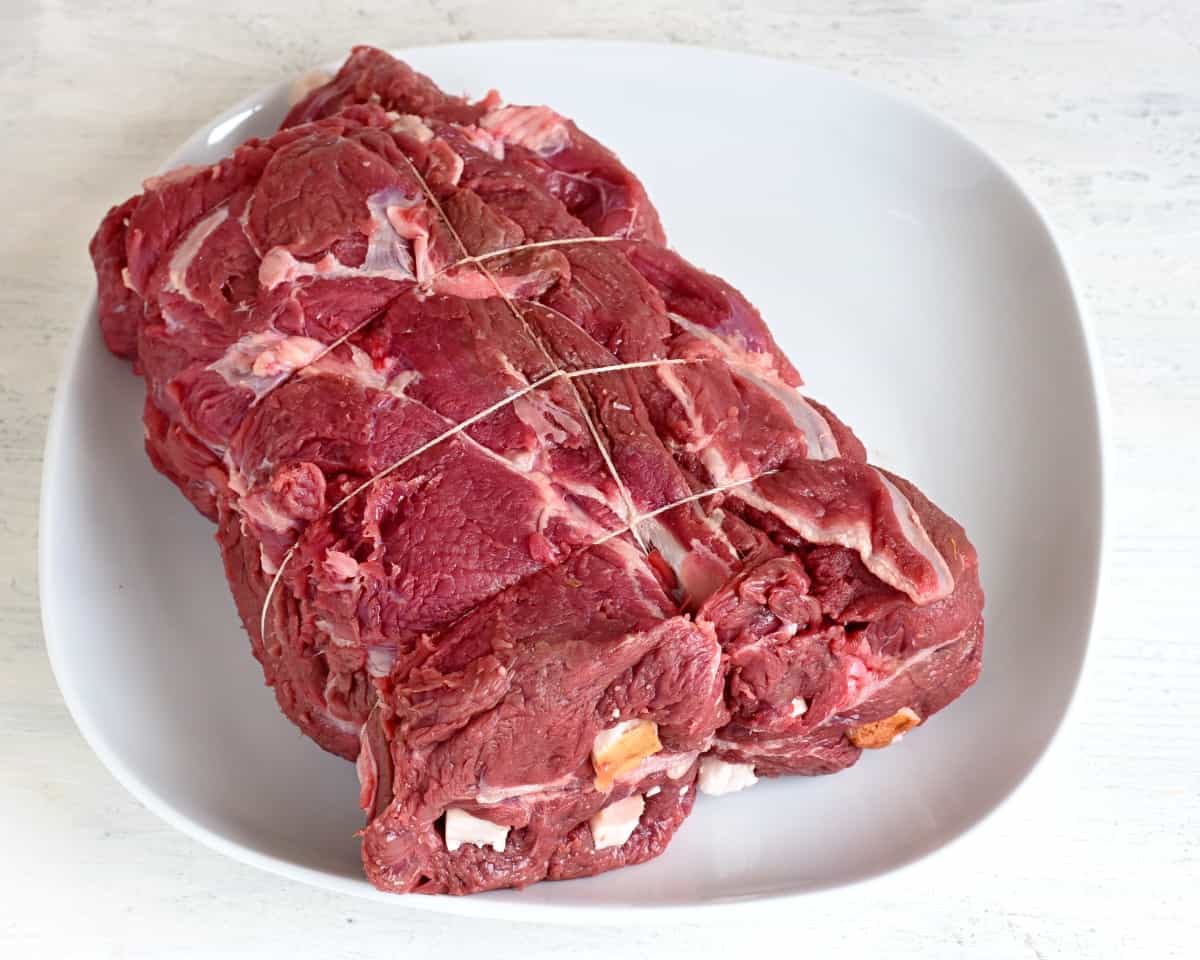
How to tie meat you can see in this video, it’s in Czech, but the cook there shows the method very well: Tying meat for cooking
After the meat is larded (and tied if you did it), salt and pepper it properly from all sides:
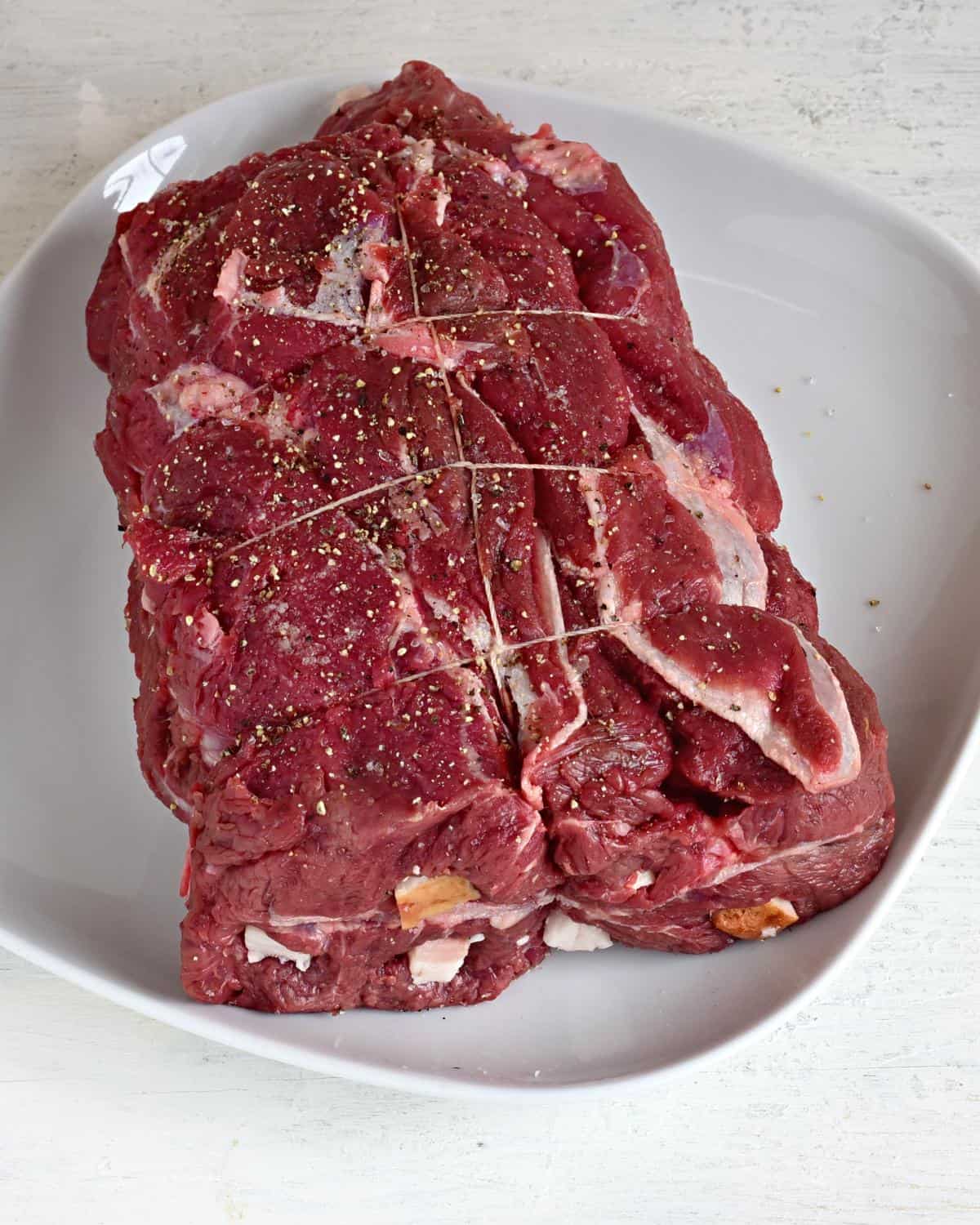
STEP 2: Prepare the vegetables and spices
- Peel the carrot, parsley root, and celeriac, and dice them into 1/2-inch pieces.
- Peel onions and chop them roughly. Peel an apple and dice it.
- If possible, tie the spices tightly to a clean canvas; you will place the canvas with spices into a pot later.
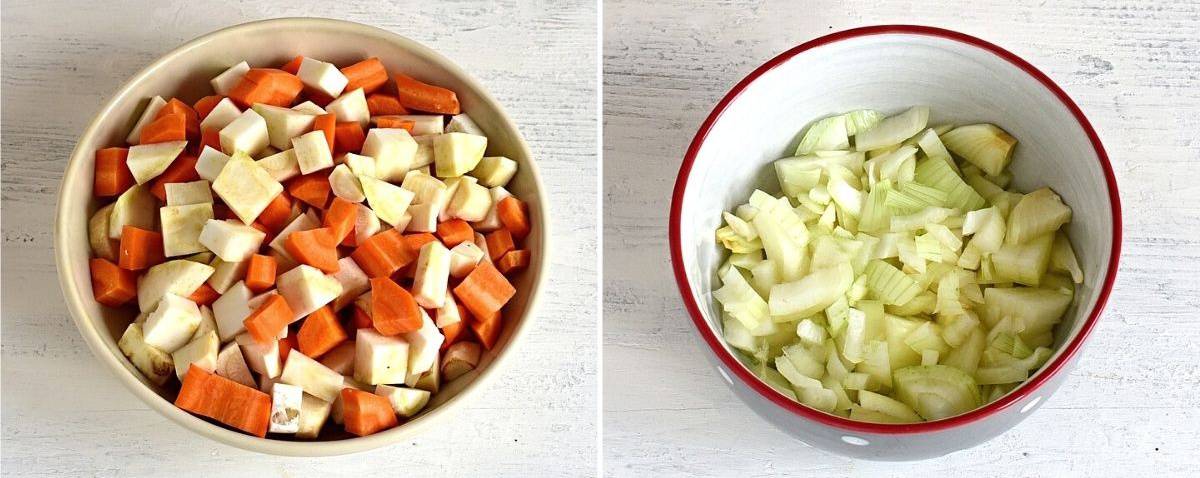
I used my old tea strainer for allspice balls and peppercorn and put the bay leaves free into a pot:
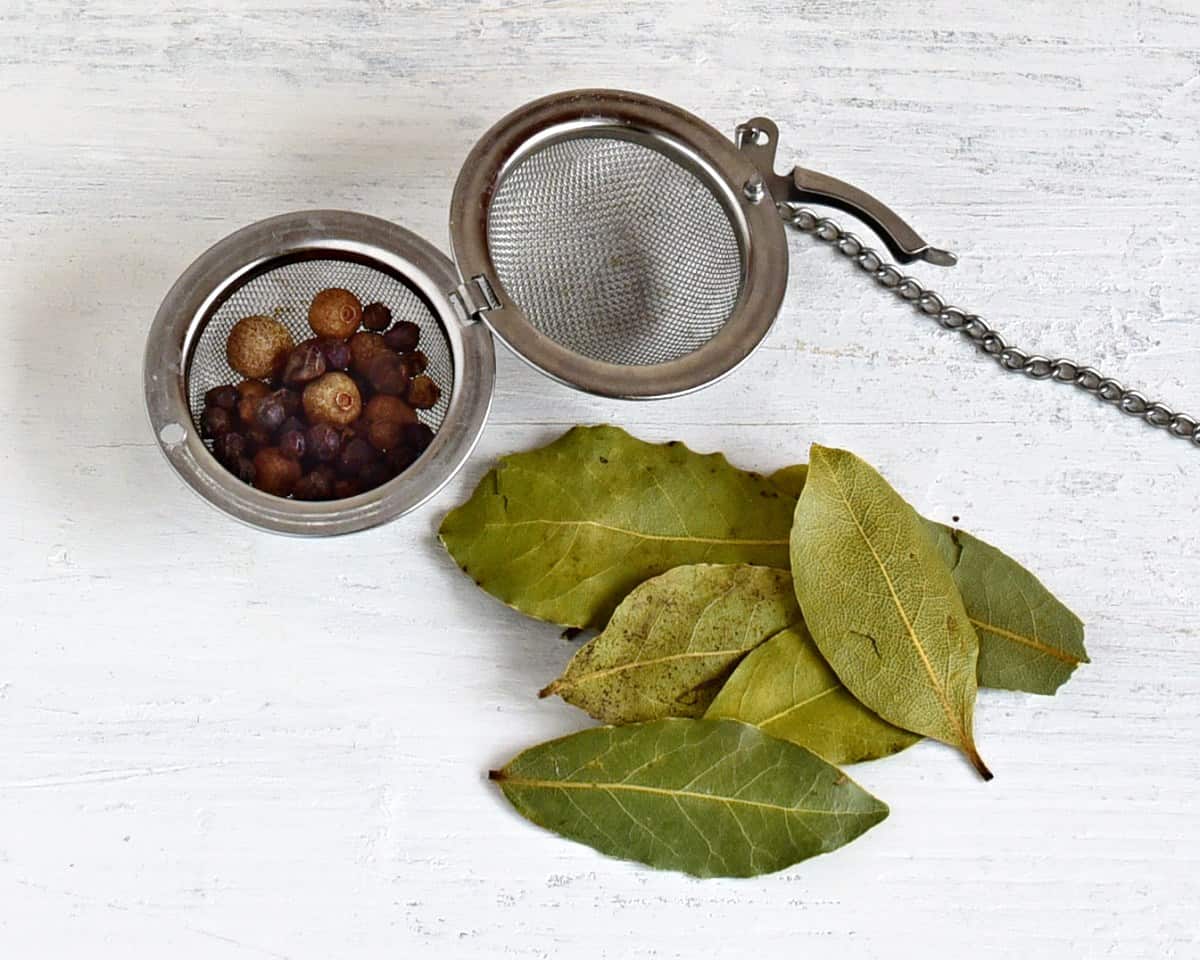
STEP 3: Brown the beef
In a large heavy pot, melt lard over higher heat and sear the beef from all sides until brown. Remove the browned meat and set it aside.
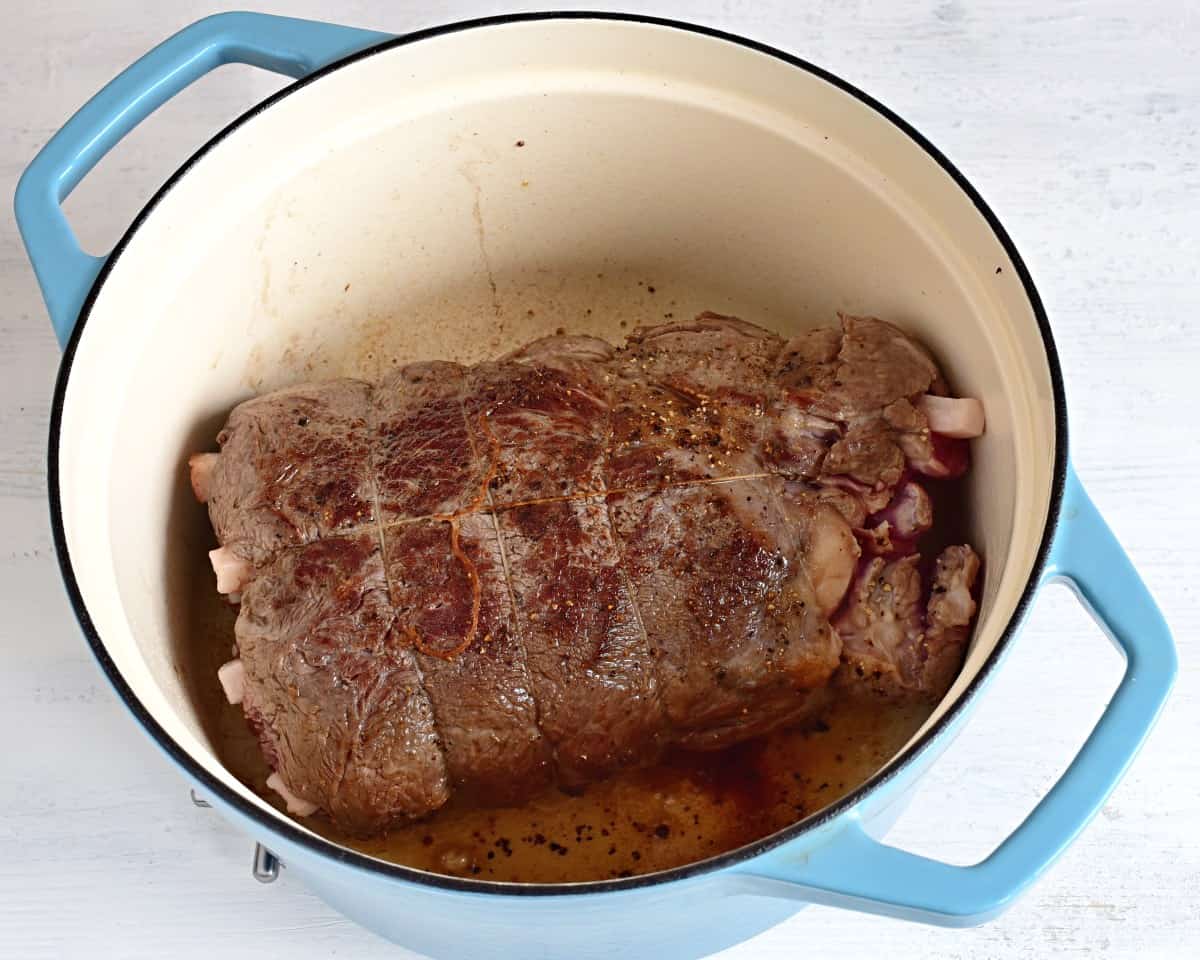
STEP 4: Sauté the vegetables
- Use the same pot that we used to prepare the meat. Reduce temperature to medium heat, and add butter and any leftover fat bacon from larding.
- Add diced carrots, parsley roots, and celeriac. Cook until slightly golden, stirring occasionally.

STEP 5: Add onions and apple
Throw chopped onions to vegetables, add a diced apple and cook for another 3-4 minutes, stirring frequently.
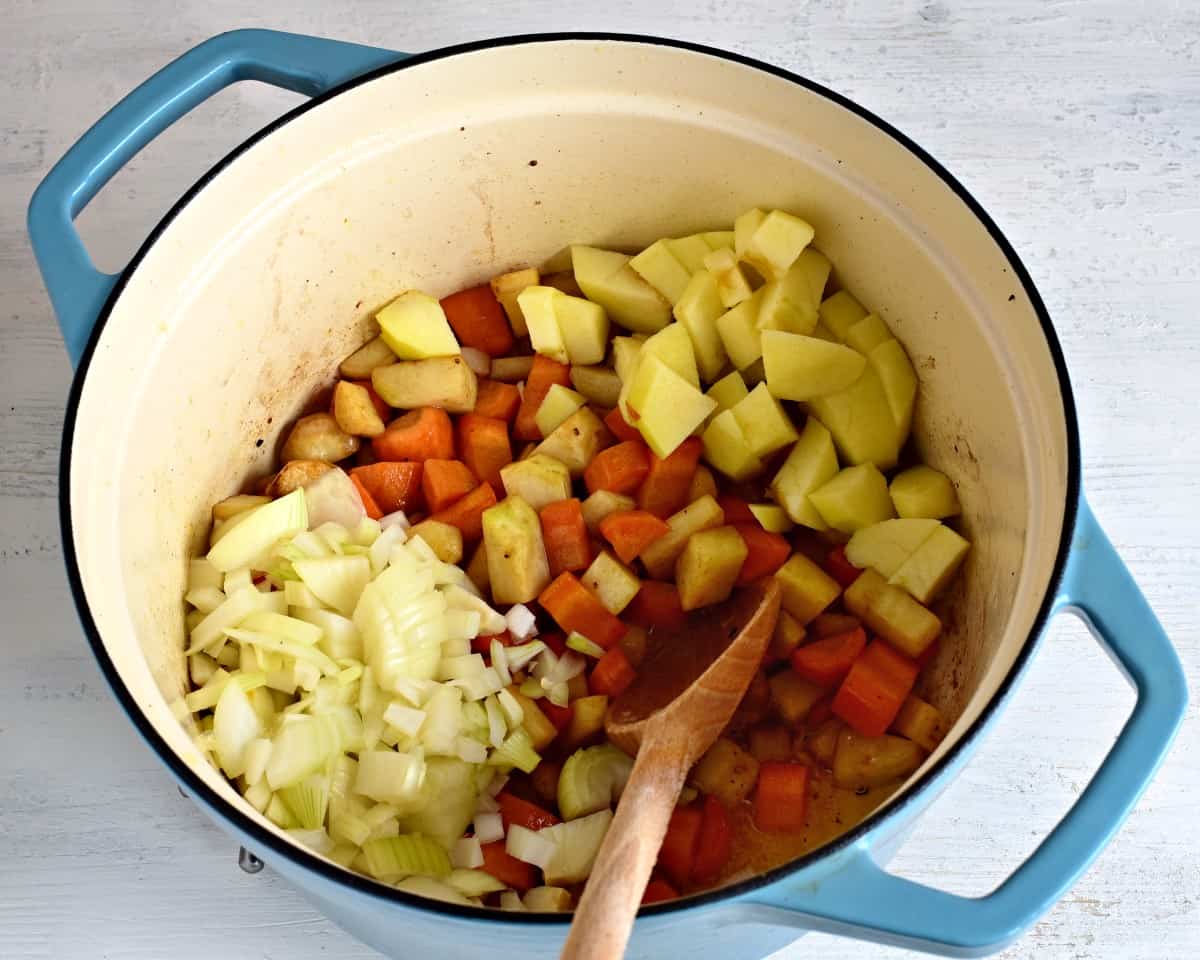
STEP 6: Add sugar and vinegar
- Add sugar, mix, and let it melt & caramelize while occasionally stirring. Count on 3-5 minutes.
- Pour in vinegar, mix, and let vinegar evaporate while stirring, so that there are only vegetables with melted sugar and some fat on the bottom of the pot. It takes a few minutes. If the vinegar stayed in the vegetables, the sauce would taste too sour!
- Add 1 teaspoon of salt and mix it.

Voilà, the base for great svíčková is ready!
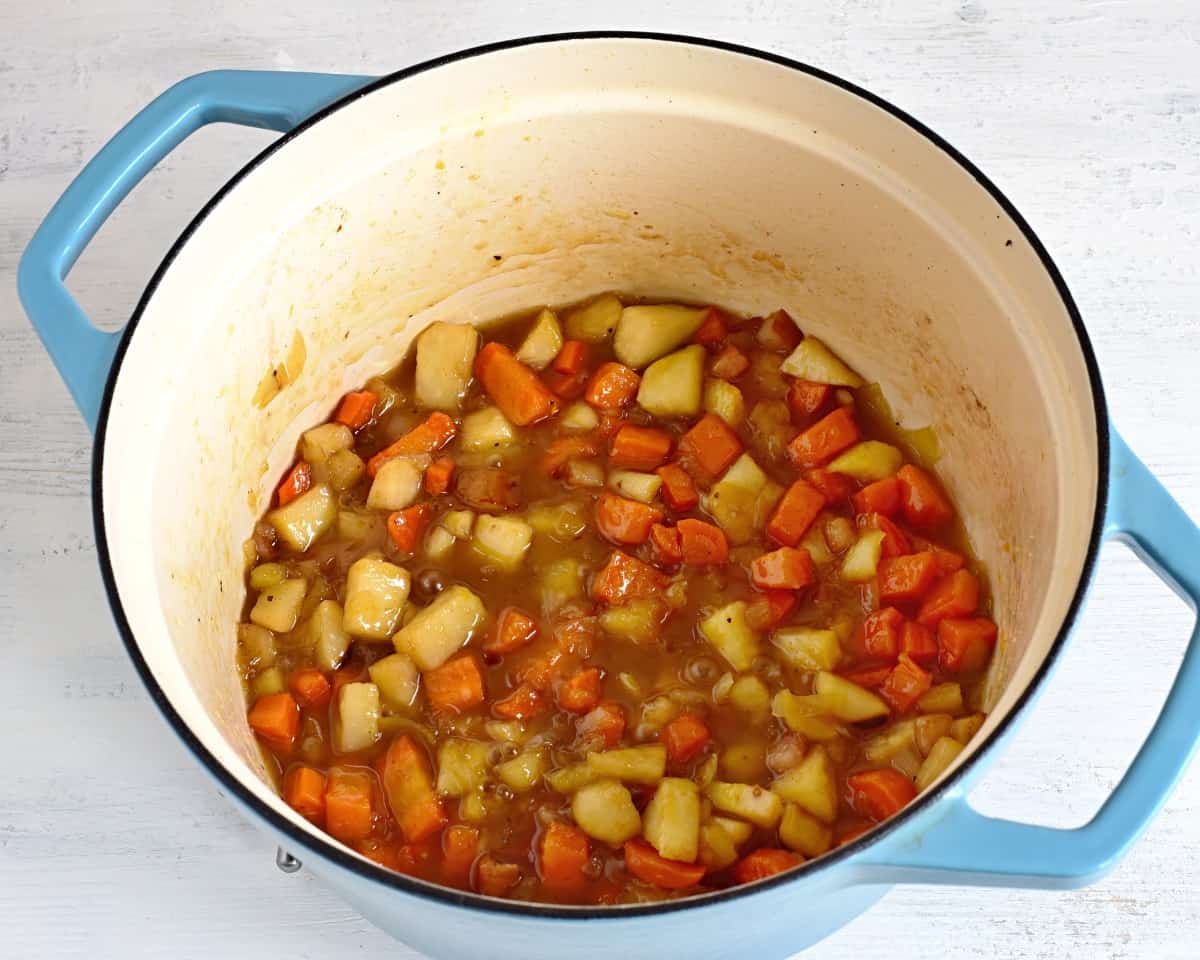
STEP 7: Return the browned beef to a pot
- Return the browned beef to a pot, and pour over hot water until you have the meat almost submerged.
- Add 1 teaspoon of salt and spices.
- Count the number of bay leaves if you add them to the pot freely! You need to remove them all later before the final mixing of svíčková sauce.
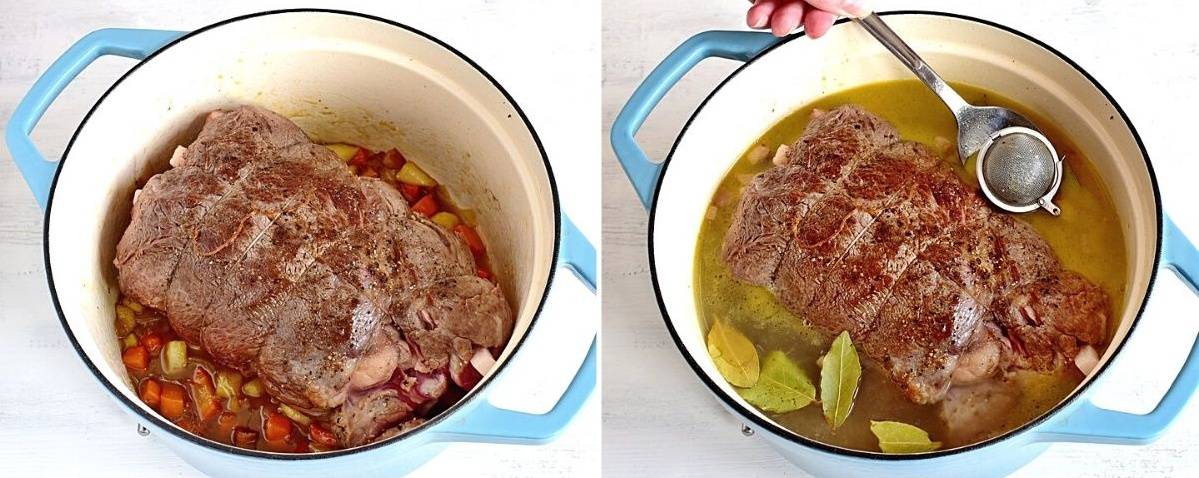
STEP 8: Bring to a boil, and reduce heat to a minimum. Cover with a lid and allow it to simmer for 2,5 hours until beef softens.
STEP 9: Remove the spices, especially all bay leaves. Remove ¼ of the vegetables and discard them. If you left all the vegetables in the sauce, svíčková would taste too much like the vegetables, and it would be too dense. Take out the beef and keep it in a warm place.
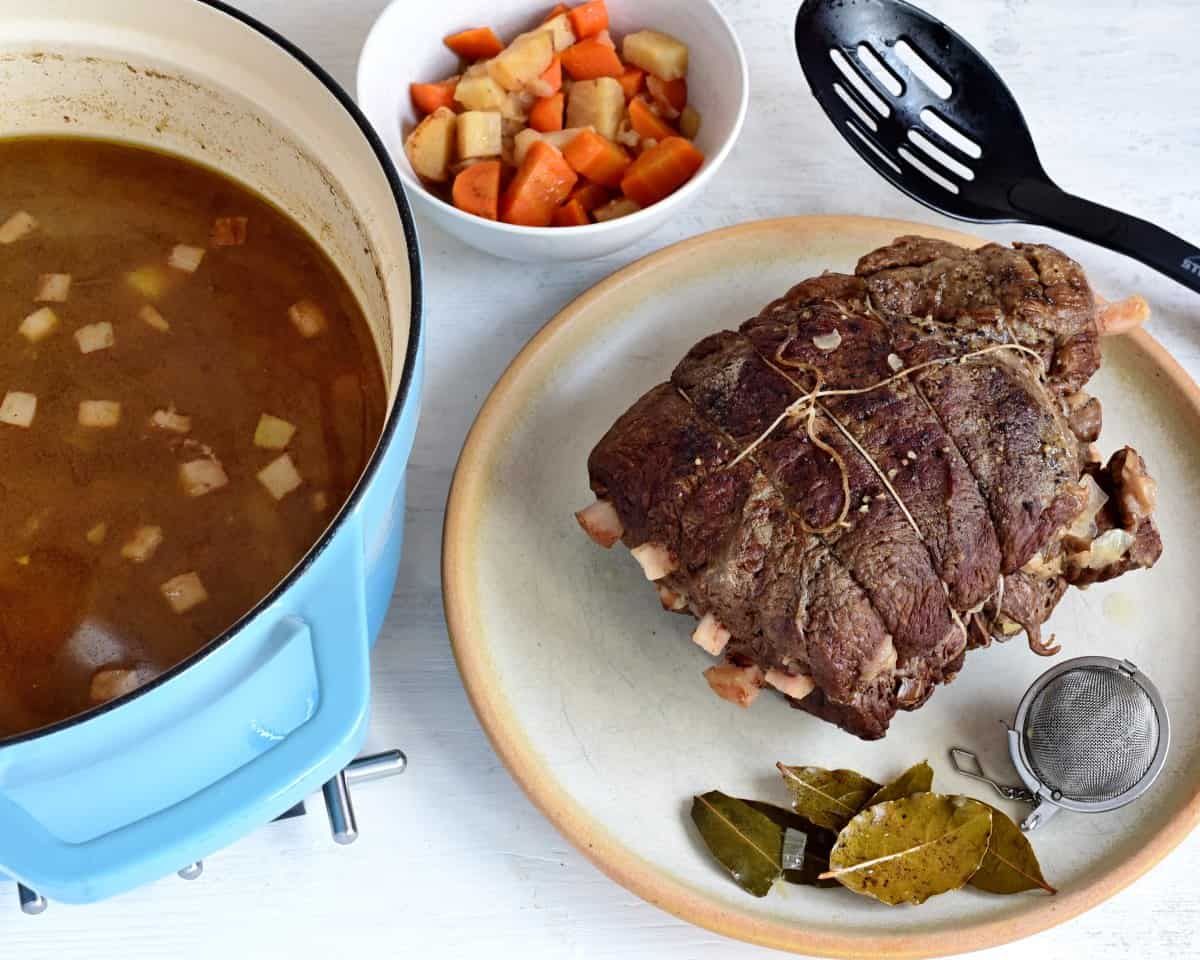
STEP 10: Make the roux
- In a pan, melt butter on medium heat.
- Add flour, and frequently mix until lightly golden.

Get a sieve, put roux in it, submerge into the svíčková, and press roux through the sieve. Continuously mix the roux in the sauce.
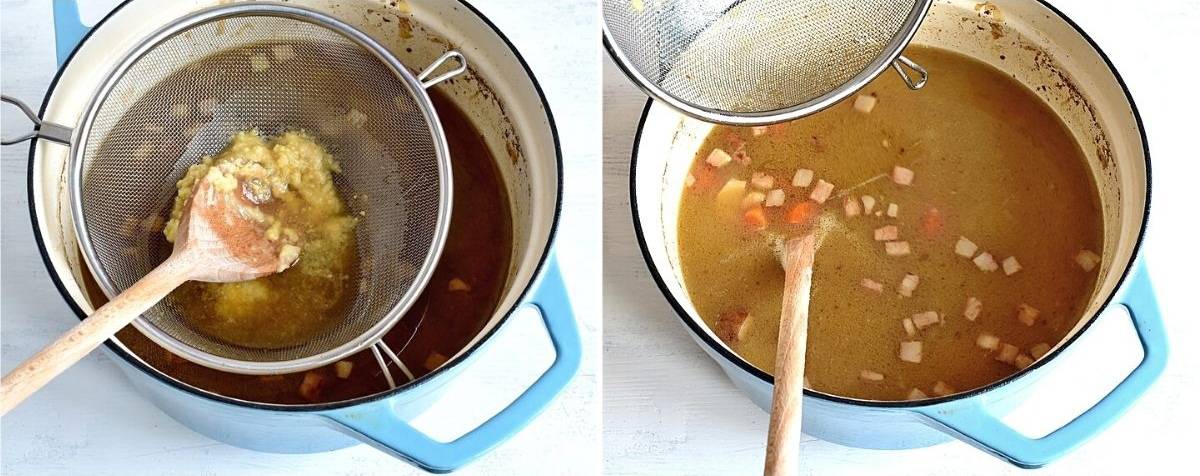
STEP 11: Bring the pot back on a stove, and let it simmer for 15-20 minutes.
Stir occasionally because the roux tends to sit down and stick to the bottom of the pot.
The roux loses its floury taste after about 15 minutes of simmering. It thickens the sauce, whose texture will be very smooth and silky.
STEP 12: Add heavy cream into the sauce and stir; no more cooking!
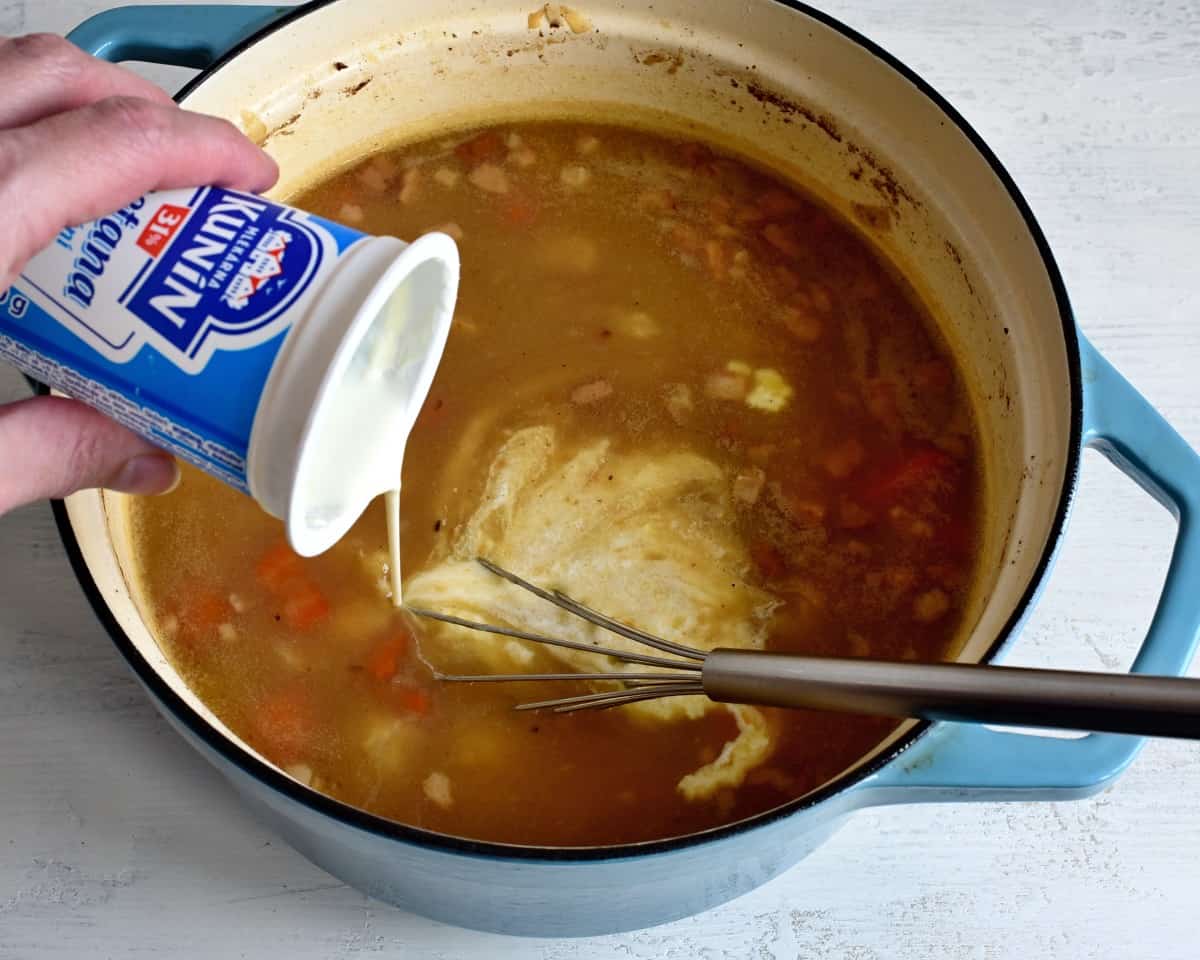
STEP 13: Mix everything with an immersion blender and strain the sauce into a clean pot. Season with lemon juice and salt to your liking.
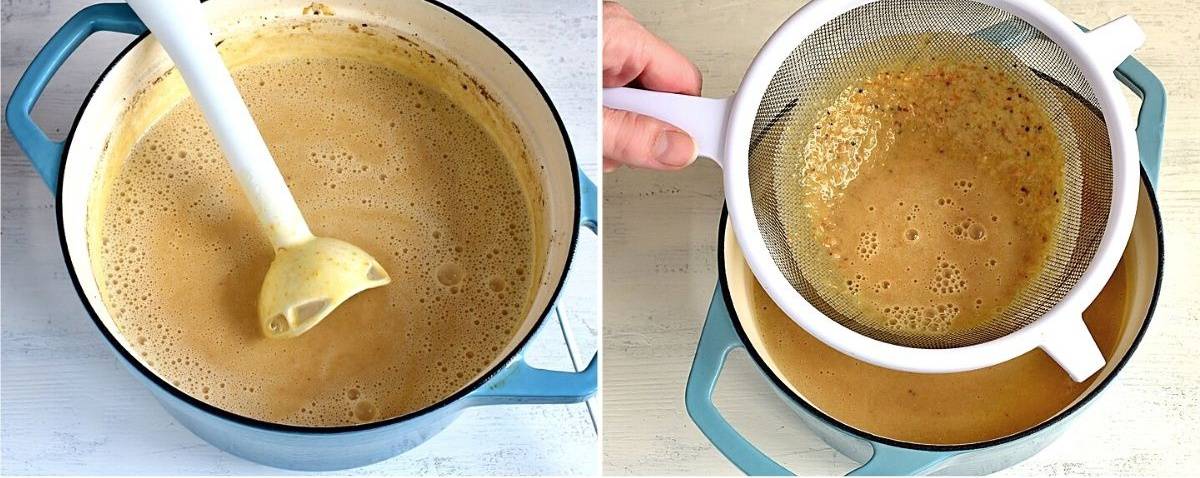
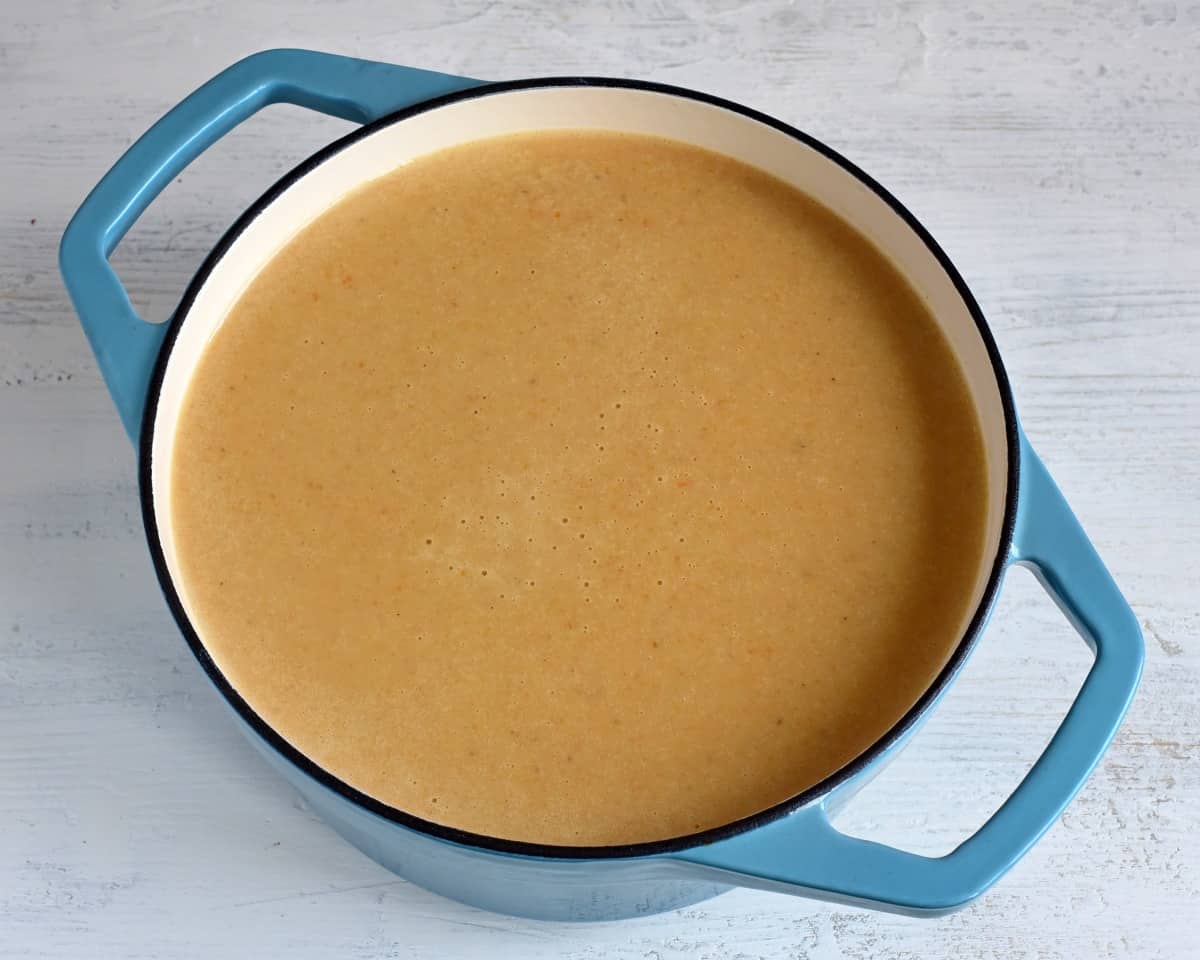
Serve with bread dumplings and a slice of beef.
You can also garnish the svíčková with a slice of lemon, a whipped cream scoop, and a spoon of canned cranberries. This type of garnishing is called “terčík” in Czech. I personally garnish svíčková with lemon and cranberry jam only.

Does your svíčková look tasty? Well, let’s go and eat it! Dobrou chuť 🙂
➜ Cook’s Tips
- On the second day, svíčková tastes even better. It’s also thicker. That’s why you have to add some water while heating the sauce, which helps it return to its regular creamy texture.
- Don’t use any cream containing less than 30 % fat. Low-fat creams added to a hot sauce can cause the sauce to start curdling.
- You must remove all bay leaves before mixing svíčková for the final time. The pieces of bay leaf are inedible and can taint the entire meal, especially if you don’t strain the svíčková over a sieve.
- If you visit Prague (the capital city of the Czech Republic) and want to order some svíčková in a restaurant, here is the correct pronunciation: [ˈsviːt͡ʃkova:]
- This recipe is inspired by Czech Chef Roman Vaněk and his cookbook “Velká kuchařka Čech a Moravy” (in my opinion, the best Czech cookbook).
Want more typical Czech dishes? Try beef goulash, Czech-style beef stew, or dill sauce, a Czech sweet-sour koprova omacka!
➜ FAQ
Although you could translate the name of svíčková sauce to "Tenderloin beef on cream," no Czech in their right mind would use this cut of meat for svíčková. Tenderloin/fillet mignon is very expensive in Czechia and is much better used for steaks. Reputable Czech cooks recommend marbled beef, for example, top blade, bolar blade, or beef shank (kližka).
Yes, you can. You can also use venison, rabbit, and turkey meat. It is always recommended to lard the meat with fat bacon.
Store the svíčková in a fridge for up to 3 days. You can also freeze it together with meat, but not with dumplings; they are always frozen alone.
Sliced bread dumplings are the most traditional side dish; other options include the so-called karlovarské dumplings or pasta. Potatoes and rice don’t pair well with svíčková.
These Czech dishes are also delicious:
- Sweet tomato gravy – famous Czech Rajská omáčka with beef and bread dumplings
- Pork schnitzel – breaded fried pork, Czech rizek (řízek)
- Sekaná – beef and pork meatloaf
- Warm horseradish sauce – Křenová omáčka
Tried this recipe?
Leave a review down in the comments! ⭐⭐⭐⭐⭐
Follow me on Facebook and Pinterest. Subscribe to my newsletter. Send me any question about Czech cuisine to my e-mail. I love hearing your feedback!
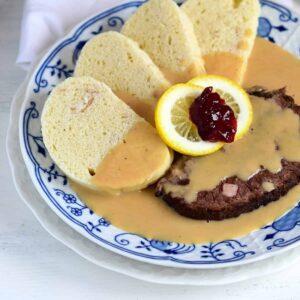
Svíčková na smetaně
Ingredients
- 3 pounds beef (1.4 kg) e.g. top blade
- fat bacon for larding meat
- 1 and ½ Tablespoons lard
- ground pepper
- salt
- 6 cups water (1,45 l) approx. amount of water, depends on the size of your pot
Vegetables for svíčková base
- 2 carrots
- 2 parsley root
- 7 ounces celeriac (200 g)
- 3 onions
- 1 apple
- ½ stick butter (55 g) unsalted
- ½ cup granulated sugar (100 g)
- ⅓ cup vinegar 5% acidity (80 ml)
Spices
- 6 bay leaves
- 10 allspice balls
- 10 peppercorns
Roux
- 3 Tablespoons all-purpose flour
- ½ stick butter (55 g) unsalted
To finish svíčková
- 1 cup heavy cream (240 ml) at least 30 % fat content
- 1 lemon
- ground pepper
- salt
Instructions
Lard the beef with stripes of fat bacon:
- Cut fat bacon into ⅓ inch thick and about 4 inch long pieces and put them into a freezer for 30 minutes to harden them.
- Use a thin knife with a long edge and make some holes into the meat.
- Stick your index finger inside each hole and wiggle it so the hole enlarges.
- You can make the holes into both sides of the beef.
- Once you have the holes ready, press in stripes of fat bacon.
- For a better shape, you can tie the irregular-shaped meat with a cooking string (kitchen twine).
- After the meat is larded (and tied if you tied it), salt and pepper it properly from all sides.
Prepare the vegetables and spices:
- Peel the carrot, parsley root, and celeriac, dice into ½ inch pieces.
- Peel onions and chop them roughly. Peel an apple and dice it.
- If possible, tie the spices tightly in a clean canvas; you will place the canvas with spices into a pot later.
Brown the beef:
- In a large heavy pot, melt lard over higher heat and sear the beef from all sides until golden brown. Remove the browned meat and set it aside.
Sautée the vegetables:
- Use the same pot which we used to prepare the meat. Reduce temperature to medium heat, add butter and any leftover fat bacon from larding.
- Add diced carrots, parsley root, and celeriac. Cook until slightly golden, stirring occasionally.
- Throw chopped onions to vegetables and cook until lightly golden. Add a diced apple and cook for another 3-4 minutes, stirring frequently.
- Add sugar, mix, and let it melt while stirring.
- Pour in vinegar, mix, and let vinegar evaporate, so that there are only vegetables and some fat on the bottom of the pot.
- Add 1 teaspoon of salt and mix it.
Cooking beef:
- Return the browned beef to a pot, pour over hot water until you have the meat almost submerged.
- Add 1 teaspoon of salt and spices.
- Count the number of bay leaves if you add them to the pot freely! You have to remove them all later before the final mixing of svíčková sauce.
- Bring to a boil, reduce heat to a minimum. Cover with a lid and allow it to simmer for 2,5 hours.
- Remove the spices, especially all bay leaves. Remove ¼ of vegetables and discard them. If you left all the vegetables in the sauce, it would taste too much like the vegetables, and it would be too dense.
- Take out the beef and keep it in a warm place.
Making roux:
- In a pan, melt butter on medium heat.
- Add flour, frequently mix until lightly golden.
- Get a sieve, put roux in it, submerge into the svíčková and press roux through the sieve. Continuously mix the roux in the sauce.
- Bring the pot back on a stove, let it simmer for 15-20 minutes.
- Stir occasionally because the roux tends to sit down and stick to the bottom of the pot. The roux loses its floury taste after about 15 minutes of simmering. It thickens the sauce, whose taste will be very smooth.
Finishing svíčková:
- Add heavy cream into sauce; no more cooking!
- Mix everything with an immersion blender and strain the sauce in a clean pot. Season with lemon juice and salt to your liking.
- Serve with bread dumplings and a slice of beef.
Notes
- Makes 6 portions.
- You can also garnish the svíčková with a slice of lemon, a whipped cream scoop, and a spoon of canned cranberries. This type of garnishing is called “terčík” in Czech.
- On the second day, svíčková tastes even better. It’s thicker. That’s why you add some water while heating up the sauce, which will help it return to its regular creamy texture.
- Don’t use any cream containing less than 30 % fat. Low-fat creams can cause the sauce to start curdling.
- You must remove all bay leaves before mixing svíčková for the final time. The pieces of bay leaves are inedible and can taint the entire meal, especially if you don’t strain the svíčková over a sieve.
DISCLAIMER: Because I come from Central Europe, my recipes are based on metric units such as grams or milliliters. Check out how I convert metric units to the U.S. system:
Conversion chart

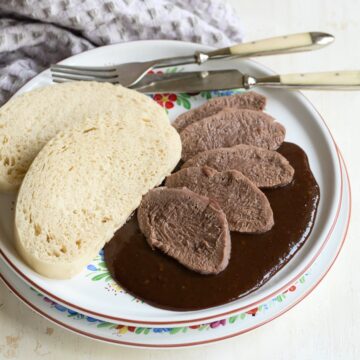
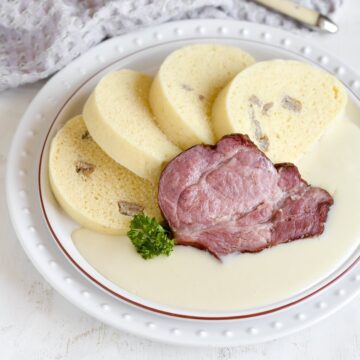

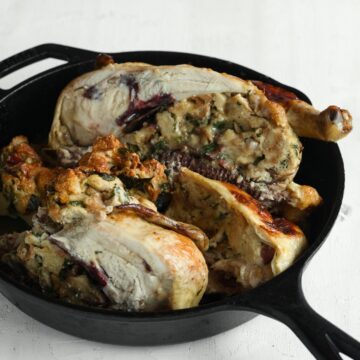
Kelly
I am making this again already because I loved it so much. I opted out of the lard, bacon, and cream. Wonderful even if you don't discard the veggies or use a full cup of sugar. I couldn't find celeriac, not even seed, but am committed to finding and trying it but may have to try growing it in Texas.
Petra Kupská
Ahoj Kelly, thank you for your nice comment and feedback! Svíčková sauce is a kind of alchemy even for Czechs, you can experiment a lot with it. I know that in the US, it can be a problem to get celeriac. Some home cooks use celery and also substitute parsley root with parsnips. In any case, I'm glad you like the svíčková! 🙂
Slávka
Help - If I just want to make the sauce without the beef, any idea how much beef stock should be added to the veggies (keeping in mind that some of the veggies will not be discarded as your recipe calls for.) - mockrát thank you!!
Petra Kupská
Ahoj Slávka, it's hard to say exactly the ratio of vegetables to beef broth. I always cover the meat in the pot so that it is almost submerged. How many people do you cook for? I would guess that one cup of broth would be the right size for one person. If you won't be removing any vegetables, try adding about 2 medium carrots, 1 parsley root, a small piece of celery (if you can get it), 2 onions, and half an apple to 4 cups of broth (just under 1 liter). It is difficult to estimate, the sauce should also be thickened with roux. Some people just mix the sauce with the vegetables and do not add the roux, but then you need to add more vegetables.
Lauren
Hello,
I am about to attempt this recipe and I have a few questions.
If I do not have a way to remove the allspice balls and peppercorn spices (such as a clean canvas), can they be puréed in smaller amounts? Or do I need to fish them out?
After the meat has been browned and everything, can I transfer it to a crockpot for the cooking?
And why do you recommend bread dumplings over potato dumplings? Is one easier than the other?
Thank you! My husband spent two years living in the Czech so I am really excited to try making this for him.
Brian
Make a "bouquet garni" of spices using cheesecloth and tie it off with twine - fish it out and discard.
Petra Kupská
Yes, this is a great idea, I agree!
Alex
About how much fat bacon to use?
Anicka Cooklikeczechs.com
Ahoj Alex,
use about 3.1/2 ounces (100 g). I recommend putting the sliced bacon strips in the freezer for about 15 minutes, they will be easier to work with. Chop the leftover bacon into bite-sized pieces and add them to the pot when frying the vegetables.
Hope this helps!
Brian
Celeriac is the root of a specific variety of celery, so just using celery in large pieces and discarding before the final prep, where the majority of the veggies get tossed, would likely work fine - don't want the stringiness of the celery in the final product. Not sure how one omits cream in a dish that is based around it... sounds a bit like making hamburgers without the meat.
Petra Kupská
The original Czech Svíčková sauce is always made with roux and smoothered with cream. Many people skip the roux and only thicken the sauce with pureed vegetables, which, in my opinion, is a significant mistake.
Grace
Such a delicious recipe! I’m cooking meals from every country and I’m so glad I chose this dish! Every part was so good but I absolutely looooved the purée! Incredible flavor!!
Petra Kupská
Grace, thank you for your kind comment; it made me happy! Czech Svickova sauce is quite complicated to make, so I appreciate your courage to try it! And of course, I'm glad that you liked the sauce 🙂
Richard
Recipes sound so yummy. I grew up in Nebraska in a Czech community- one lady used to make liver dumplings- I don’t know what kind of livers she used. Do you have any Czech recipes for that type of soup
Petra Kupská
Ahoj Richard, thank you for your comment! I don't have a recipe for this soup on my blog yet, but I'm going to! It is for sure a Bohemian liver dumpling soup. Liver dumplings are usually made with finely minced chicken or pork liver and put into the soup to cook at the very end. Thanks for the reminder; I'll try to make the soup as soon as possible.
Daniela
Petra - as with all of your recipes, I am never disappointed! For years I was cooking Svickova the way I learned when young, marinating the meat for 3 days...I am so happy you provided this recipe that doesn't require that but still provides the authentic taste and flavor! Just as delicious as when my mom used to cook it. I also made your bread dumplings with it. Just like being back home 🙂 - Thank you!!!
Petra Kupská
Ahoj Daniela, thank you so much for your nice comment! I learned to make Svickova from Czech chef Roman Vanek, whose recipes work perfectly. He doesn't marinate the fillet either, the sauce can be completely prepared during a half day! I'm so glad you liked the dumplings too 🙂 Have a wonderful Advent, Petra
Shari-Anne Rice
my dedo's favorite meal babi told me. maybe this is a way to keep your man lol. I miss babi and dedo. christmas doesnt feel the same, I am dedicated to have czech christmas's. Funny even my name is spelled the czech way.
Petra Kupská
Ahoj Shari-Anne, thanks a lot for your comment! It made me laugh so much to think that thanks to the svickova na smetane, Czech husbands are sticking to their wives and not running anywhere else. You know, the way to a man’s heart is through his stomach, and Czech women, girls, mothers, and babi know that well. Have a peaceful (Czech) Christmas! 🙂
Shari-Anne Rice
Thank you for this recipe, i made bean soup with my babi as well. I wouldn't trade these memories for anything.
Petra Kupská
You are very welcome! Bean soup is another delicious Czech dish (I must make it soon too). I believe your babicka was not only a great cook but also a very close person who made sure you had a wonderful childhood 🙂 By the way, Shari means Šárka in Czech?
Simona
Hi Petra,
Thank you so much for keeping up your wonderful blog! I only know svickova as being marinated for up to a week, I am excited to try your version, now that my mom is gone….
I think you have a small translation error that’s causing little bit of confusion in an English speaking group I am part of for things Czech.
The correct translation for “svickova” would be “tenderloin” - the most expensive cut of meat (also called fillet mignon”. Sirloin is a cheaper cut and is not equivalent with svickova.
Petra Kupská
Ahoj Simona, thank you very much for your lovely words and useful feedback! You are right, the correct word is tenderloin, I'll fix it in the recipe right away. I apologize for any complications this inaccuracy may have caused you. On the other hand, tenderloin is not typically used to make this cream sauce. The best meat for Czech "svickova" is whole top blade. This cut has good marbling and flavor. Braising is the best method for cooking the top blade roast because the moist heat and lengthy cooking time help tenderize the meat.
Ishil
Hey Petra, thanks for this recipe! I am a foreigner married to a Czech guy and when I cooked it for him, he said "it tastes exactly like my mum's":))))) I felt so happy. I also tried your other recipes. All turned out to be so well.
Thanks again for this wonderful blog:))))
Petra Kupská
I am so glad to hear this! Thank you for your lovely words 🙂
James Traver
I would have given your Svickova six stars if it were possible! We live in Missouri, USA, and my wife has picked up that tick problem that makes her allergic to red meat. We had your mushroom soup early in the week and I wanted to try this. I saw turkey thighs at the grocer and was inspired. Like others I used a variety of root vegetables, and plant-based cream. It worked well. Svickova truly is the queen of sauces. Everything else on the plate is just an excuse to pour the sauce on top. Thanks for your blog.
Petra Kupská
James, thank you very much for your so nicely-written words! 🙂 You can make Svickova with chicken or turkey legs as well; Czechs sometimes use rabbits or venison, too. I always recommend lard the meat with bacon for a better taste. Also, use a good quality stock to give the sauce a solid base. All the best to you and your wife, Petra
Theodora Zemek
Long story, but I was donating some bedding for the Ukraine and discovered that the drop-off point was a wonderful, bright and cheerful Polish grocery in Edinburgh, which had all sorts of the mysterious items that my Czech relatives used to buy in Chicago. Feeling my Eastern European genes stirring, I decided to make Svickova and knedliky for Sunday lunch, using your recipes. I hadn't actually eaten either since probably 1973 (I am 66 !) and even then we bought the dumplings ready made. I do remember my great aunt Rose, the family dumpling maker, taking an enormous, threatening -looking knedliky from a pot and being terrified, aged 4, - though they were reputed to be delicious. I followed your directions and they were absolutely clear and easy to follow. I used brisket for the beef , which worked well, although I will use feather blade next time - it just wasn't available. The balance of veg, sugar and vinegar is perfect, and the sauce was excellent. I was a bit traumatised by the knedliky but forged on, having obtained the special flour from my new Polish friends - but they were dead easy - once again the recipe was perfect. To my horror I had lost the cord for my steamer - so I boiled them and they were - absolutely perfect, light, fluffy and tasty. My son and his Scottish pals absolutely hoovered the lot. I thought dinner would be an interesting curiosity - but in fact they loved it all so much that this will become a regular in my repertoire. Thank you very much ! Keep up the good work. I am now going to see if you've got a recipe for kolacky !
Petra Kupská
Ahoj Theodora, thank you very much for your lovely comment!
I am glad that you mention support for Ukraine because we are significantly impacted by the situation here in the Czech Republic. After all, Czechs had experience with the Russian occupation in 1968. We are trying to help as much as we can.
I'm also very pleased that the svickova sauce was a success! Also congratulations on mastering the bread dumplings, even many Czech housewives have respect for them.
And if you do tackle the kolacky cookies, be sure to let me know how they turn out.
My best to you and your family, Petra.
Margret
What a lovely story and comment! We're going into autumn here in Australia and your comment has cemented my determination to try this recipe - I'm sure my Scottish husband will enjoy it!
Josefina Vrbik
Hi Petra,
Thank you for the recipe and for the extra tips that you gave us. Your recipe is as good as the one I had when I visited my sister in law in Prague. You solved the great mystery of her well guarded secret (lol) her velvety, sweetish, tangy svicova sauce. Thanks to you I can imitate her Czech cooking now with confidence.
Petra Kupská
Ahoj Josefina, thank you very much for your lovely feedback! I am happy I can help, and I believe you'll have success with this svickova recipe 🙂
Kelli
Thank you so much for this recipe. My grandmother made this when I was little for Sunday meals very often. I haven't had this for nearly 30 years, and this reminds me so much of her!
Petra Kupská
You are very welcome, Kelli! Meals from grandma or mom always taste the best, and that's the way it should be 🙂
David
I stopped at a country restaurant on my way back to Poland from Germany Oct. 22 and had this dish. Wanted a recipe that matched that great meal I had. I managed during that trip to buy loafs of bread dumplings so had those on hand. My inlaws returned for Winter/Christmas to Poland today so made this dish. I used pork shoulder as beef is expensive and sliced before cooking. I left out bacon and lard. In Poland, think Czech is same, the root vegetables in recipe come in a package in the exact quantities noted excluding onions. Taste was on par with what I ate in Czech. Even as an American I prefer the central/eastern European cuisines. My inlaws and Polish wife loved it. Thank you for sharing. I have one loaf left so will make it again. Wish I could share pic of the root package. Smacznego Chutné
Petra Kupská
David, thanks a lot for your nice words! I am happy you enjoyed the Svickova sauce. Btw, I always have a package of root vegetables at home, it is absolutely perfect for any kind of cooking (sauces, soups, even salads). This is what the current one looks like 😉
David
Read your profie. While we bought a home close to Poznań my inlaws have an apartment in Jelenia Gora. Same region as you. I love to visit Harrachov and when we visited/lived in Southern Poland my grocery trips to Zittau Germany took me thru the area you lived.
Petra Kupská
Hi David, what a nice coincidence! Right, Jelenia Gora is not far from us, and so is Zittau, where we go shopping, just like you 🙂 A visit to the hill Oibyn with the ruins of the medieval castle is also very nice; I highly recommend it!
Ty
Ahoj Petra, I’m making this recipe for my foods and cultures class in school, but I can’t find parsley root, do you have any substitutes that you would suggest?
Petra Kupská
Ahoj Ty, if you can't get parsley root, I think one option is to substitute parsnip. Alternatively, you can omit the parsley altogether. Good luck with the Svickova sauce!
Edward
A question for you. I haven't had svickova since my grandmother was alive and I cannot wait to make this recipe. However from what I remember, when my grandmother made her svickova, I can remember my grandmother pickling the beef for a few days in the fridge before cooking. Is my memory off and that 4 day pickle for a different dish? Appreciate you help!
Petra Kupská
Hi Edward, thanks for your question. When it comes to pickling beef, there are recipes that call for pickling, but there are also recipes that skip this step. Pickling takes two or more days, and today the preferred method is to make the sauce without pickling. Preparing and seasoning the vegetables at the beginning of the recipe will add the desired flavor to the sauce (see instructions, please). Hope this helps! Petra
Elke
Ahoj Petra, I grew up with the Bohemian cuisine of my grandmother (all my family belonged to the German community in Czechia), so I am familiar with many of your recipes. The apple in the Svickova is new to me, but it sounds perfect, so I will try it next time. Thank you!
Petra Kupská
Ahoj Elke, thank you for your comment! The apple in the svickova sauce helps to balance out the sour taste after the vinegar is added. Although apple is not used in all svickova recipes, it has worked well for me. Otherwise, this fruit is a recommendation from Czech chef Roman Vanek, who provides recipes that are absolutely delicious! All the best, Petra
Katerina
Ahoj Petra. This is the second time I've used your recipe and each time it's turned out perfect. I've tried to cook Svickova before using other recipes, but it has never turned out very well. My parents were Czech, though I grew up in Australia and now live in the UK, and my whole family love Czech cuisine. I cooked Svickova today for my son's birthday and he absolutely loved it. Thanks for sharing.
Anicka Cooklikeczechs.com
Hello Katerina, I am happy to hear the cooking worked out! What can I say, refined Czech taste is undeniable 🙂
William Souhrada Miller
My grandmother was dead but now I’m exploring my Czech roots. This one is in the pot! Let you know how it turns out.
Anicka Cooklikeczechs.com
Hello William, I am sorry about your grandmother. Thank you for your comment and kind words - looking forward to hearing from you. 🙂
Dan
This brought back some childhood memories! Not only did I make the Svickova, but the potato dumplings! Was awesome. My only question is the addition of the sugar. Is this a regional variation? I found my grandmothers recipe and it does not have sugar in it. Otherwise it was so good.
Anicka Cooklikeczechs.com
Hello Dan, sirloin sauce has a sweet taste. It is partly made of root veggies, but sugar is also usually added to balance the flavour. Otherwise, there are several variations of the sirloin recipe, and it is quite possible that some of them do not contain sugar - like your grandmother's.
Andrea
Petra, thank you so much for this blog and recipes for Svičkova and knedliky. My son had this dish several times while we were traveling in the Czech Republic years ago and it is his favorite. He asks for it every year on his birthday and I am, once again, turning to your delicious recipe to prepare this dish, a family favorite.
Whole top blade has proven difficult to find, so we use filet mignon. It is delicious! We also keep the leftover sauce and freeze it so we can have the dish multiple times over the course of a month.
We also use lingonberries instead of cranberries/cranberry jam because they are easier to find (normally in the international food section).
We get excited every year to have this special dish ❤️
Anicka Cooklikeczechs.com
Ahoj Andrea, thank you so much for your lovely comment and useful feedback! I can see that your son has a refined taste 🙂
My best to you and your family!
Dashka
Hi Petra
I hope you are doing well . I just wanted to let you know since I found your website I have been cooking czech food non stop . ( my son doesn’t eat any other food . Only Czech foods )
And after 2 years of non cooking by looking at your website . Now I can officially say I can cook most foods without looking at recipes. All thanks to you
.
My son and my husband forever greatful to you. That they don’t have to go back to Czech Republic’s to eat the food they enjoy 😉
Lots of love from Canada
Dashka
Anicka Cooklikeczechs.com
Hello Dashka, that is wonderful to hear!
I am so glad the site gave you to inspiration to cook Czech food and congratulations on mastering the cuisine! The comments about your husband and son made me smile - I fully support their refined taste 🙂
Thank you for your comment and I wish you good luck with all your future cooking!
My best to you and your family from the Czech republic!
Juanjo Rodriguez Alvarez
Dear Petra,
I've been following you for over a year now, and your recipes are always my go-to reference when cooking Czech food. My partner is from Prague and his favourite things are - as it should - Svickova and Goulash.
Had never made Svickova as he always said that it was very complicated and his Grandmum always was exhausted when making it. I made it yesterday for him and his Aunt who is visiting us, and it was a knock out of the park!
The only couple of things that I did was that I also added some Leeks to the vegetables - our Aunt said that this would bring a nice earthy flavour on top of the other veggies. And I also added a cube of high quality beef stock when I added the water.
The taste was glorious! Thanks for sharing this recipe.
One other comment, I did make the recipe on my Crockpot Multicooker and I had the meat turbo pressured in 1 hour, it was so tender and flavourful.
Really recommend for anyone to have a go at this recipe!
Enya
A fantastic recipe that everyone we knew really enjoyed! Thanks and keep it up!
Anicka Cooklikeczechs.com
Ahoj Enya, thank you so much for your kind comment - happy to hear the recipe was a success! Will sure try to! 🙂
VLADIMIR MINARIK
Somebody already asked.....2 parts of carrot, 1 part parsley roots and 1 part of celery......if bulk carrot, bite a small sample as it can be bitter (old or overgrown).
I am preparing sauce separately using beef broth and meat in the oven.
Jizku do svickove??? After 1 1/2 hr. vegetables are nearly melted.
After fishing out spices, put the mixture to a blender and correct thickness with broth.....it should nicely sticking to table spoon.
After that add in pan thick cream.......it will thicken the sauce.
Except, maybe, few drops of lemon, there is no need for other taste corrections. This way the sauce is perfectly smooth.
Anicka Cooklikeczechs.com
Hello Vladimir, thank you for your feedback.
The sirloin really belongs to the traditional Czech Svickova sauce. Thanks to the roux, the sauce is velvety soft and does not soak into the dumplings as if the sauce is made without roux.